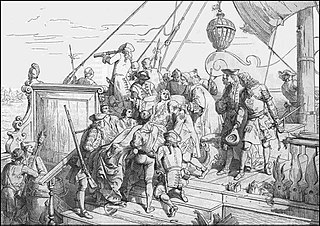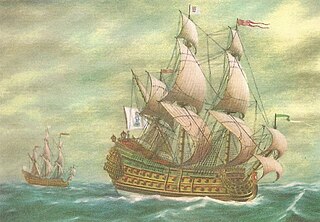
The Battle of Cape Matapan was a naval battle during the Second World War between the Allies, represented by the navies of the United Kingdom and Australia, and the Royal Italian navy, from 27 to 29 March 1941. Cape Matapan is on the south-western coast of the Peloponnesian Peninsula of Greece.
The Battle of Andros took place on 22 August 1696 southeast of the Greek island of Andros between the fleets of the Republic of Venice and the Papal States under Bartolomeo Contarini on the one side and the Ottoman Navy, under Mezzo Morto Hüseyin Pasha, and allied Barbary forces on the other. The encounter was indecisive, and no vessels were lost on either side.
There was a series of battles that took place in 1697 when the Venetian fleet, under Bartolomeo Contarini, hunted down the Turkish fleet in the Aegean Sea.

The Action of 8 July 1716 was an indecisive naval battle that took place on 8 July 1716 during a Turkish attempt to capture the island of Corfu (Kerkyra), off the west coast of mainland Greece.

The Battle of Imbros was a naval clash that took place on 12, 13 and 16 June 1717 near Imbros in the Aegean Sea, between the sailing fleets of Venice and the Ottoman Empire. The outnumbered Venetian Armada Grossa, under the Capitano Straordinario delle Navi Lodovico Flangini, proved herself able to match a superior Turkish force under the Kapudan Pasha Hodja Ibrahim Pasha in a manoeuvred fight that lasted nearly ten days. The outcome of this tough battle was unclear, since both fleet retired to their bases badly damaged, after Flangini died of wounds on the 22nd.

Cape Matapan, also called Cape Tainaron or Taenarum, or Cape Tenaro, is situated at the end of the Mani Peninsula, Greece. Cape Matapan is the southernmost point of mainland Greece, and the second southernmost point in mainland Europe. It separates the Messenian Gulf in the west from the Laconian Gulf in the east.
The Holy League of 1717 was one of many coalitions organised by the Papal States to deal with the Ottoman threat. This last one comprised Portugal, the Republic of Venice and Malta.

The naval Battle of the Abrolhos took place on 12 September 1631 off the coast of Pernambuco, Brazil, during the Eighty Years' War. A joint Spanish-Portuguese fleet under admiral Antonio de Oquendo defeated the Dutch after a six-hour naval battle.

Nossa Senhora da Conceição was launched at Lisbon on 13 July 1771 for the Portuguese Navy as a first rate ship of the line of 90 guns. In 1793 she was the flagship of the squadron that the Portuguese Navy provided to assist the British Royal Navy's Channel Fleet. The next year the Portuguese government refitted her and changed her name to Príncipe Real. In 1798-1800 Príncipe Real served in the Mediterranean as the flagship of the Portuguese squadron assisting Admiral Nelson.
HMFMS Santa Rosa was a Portuguese galleon that exploded and sank in the Atlantic Ocean off Recife, colony of Brazil, while she was on a voyage from Salvador, Brazil, to Lisbon, Portugal, under the command of Captain Bartolomeu Freire de Araújo.
The San Lorenzo Zustinian class were a class of at least twenty-nine 70-gun third-rate ships of the line built by the Venetian Arsenale from 1691 to 1746, in three different series with minor changes in the ships' length. It was the most numerous class of ship of the line built in Venice, and the last to see active service in a war against the Ottoman Empire in 1718. All this class' ships were planned before 1720, and the vast majority was launched before the Peace of Passarowitz. The last four vessels were completed to 70% in 1720s, then stored in the roofed shipbuilding docks of the Arsenale to be finished and launched between 1739 and 1746, a solution that was widely used with the following Leon Trionfante class.

Lodovico Flangini was a Venetian noble who served as Capitano Straordinario delle Navi during the Seventh Ottoman–Venetian War.

Nossa Senhora da Conceição was a 80-gun ship of the line of the Portuguese Navy, built and launched at Lisbon in 1701.

D. Lopo Furtado de Mendonça, 1st Count of Rio Grande and 12th Lord of the Majorat of Quarteira was a Portuguese nobleman and naval officer.










